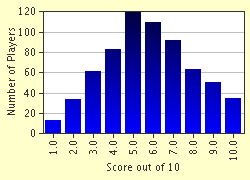Quiz Answer Key and Fun Facts
1. Ah, good. You're safe inside the quiz now. If you leave (A), then you'll miss out (B). So, if it's true that if you leave then you'll miss out (A-->B), and you do leave (A), could you then deduce that you'll miss out?
2. And you're still here. Now if we use a valid deductive logic of sentences it should be impossible for our premises to be true and our conclusions false. Suppose it's true that if you're bored (C), you leave(A), ie. (C-->A). What is a valid conclusion according to sentential logic if you are bored(C)? (Remember if you leave (A), you miss out (B), ie (A-->B).
3. You're still here. I don't think we need to speak further about leaving and missing out. Instead suppose that P stands for the sentence, "A person is a man." Suppose that Q stands for the sentence "A person makes male hormones." Symbolically speaking P-->Q means that if a person is a man, then a person makes male hormones. Suppose P-->Q is true. If ~Q, that is, if it is not the case that a person makes male hormones, then what could be a valid logical conclusion?
4. Four rules of inference are used in the sentential logic of Kalish and Montague. Here is one: If it's not the case that a sentence is false, then the sentence is true. What is this rule termed?
5. Another inference rule that seems trivial and yet becomes necessary in many proofs is that if it is the case that a sentence is true then it's true. A --> A. What is this rule termed?
6. The fact that if a sentence A is true, this requires sentence B to also be true is notated A-->B. If in a proof you establish the truth of A as well as the truth of A-->B and want to claim that B is true, what is the name of the rule that substantiates your claim?
7. The fourth rule of inference is the one that is counterintuitive and confuses many. If A implies B (A-->B) and B is false (~B), then A is false (~A). For example: if a figure being square implies it has four sides then if a figure does not have four sides it is not a square. (If a figure is not a square it can still have 4 sides, a rectangle for example.) What is the rule that says "A-->B and ~B entails ~A" called?
8. You start out with premises and wish to construct a valid argument proving your conclusion. You proceed step by step justifying each one with an appeal to a valid inferential rule and the result is your conclusion. What have you constructed?
9. You have a list of premises and a conclusion you wish to prove. You begin by assuming your conclusion to be false. You then proceed step by step using valid rules of inference ultimately showing that assuming your conclusion to be false and your premises true produces a contradiction. What have you constructed?
10. You cleverly devise your premises so that they include a contradiction. If you are permitted to use these premises sentential logic can be used to produce an argument having any sentence you chose as a conclusion: "Plato is a twit," for instance. If fact, contradictory premises can be used to show that a sentence is both true and not true.
Source: Author
uglybird
This quiz was reviewed by FunTrivia editor
agony before going online.
Any errors found in FunTrivia content are routinely corrected through our feedback system.

